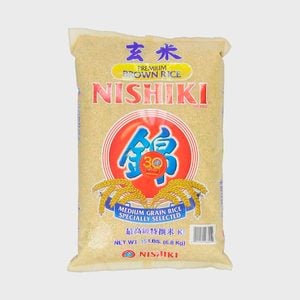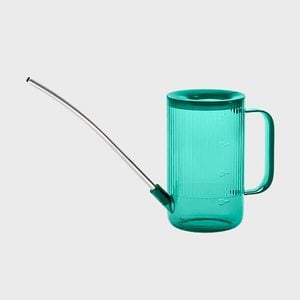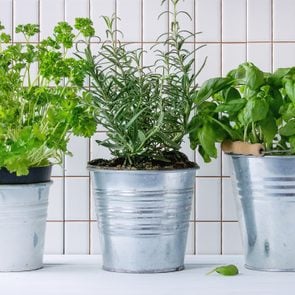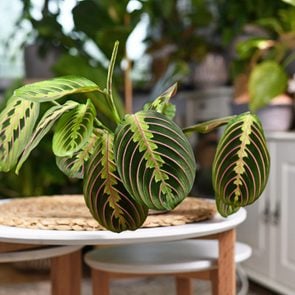How to Use Rice Water on Plants to Make Your Garden Thrive
Updated: Mar. 08, 2024

Reduce kitchen waste and grow a healthier garden—both indoors and out!—by making your own rice water for plants
Gardeners are always coming up with new and creative ways to help their plants grow better. And homemade products like coffee grounds for plants, eggshells for plants and banana water for plants have all shown promise for supporting the growth of outdoor and indoor plants. But according to several studies, rice water for plants may be one of the most useful natural fertilizers yet, and you can easily make it at home.
As any gardener knows, plants need sunlight, soil and water to grow properly. But once you have “the basics of plant care down, it’s great to give your green babies a boost so they can thrive,” says Aaron Deacon, founder and owner of Bios Nutrients. “Three ways to do this are: fertilizers (macronutrients), supplements (micronutrients) and soil enhancers. And the cool thing is, you can make all three nutrient boosters from items you may already be adding to your shopping cart.”
Even if you don’t know how to compost, affordable homemade fertilizers like rice water are incredibly easy to make, and they’re a handy alternative to chemical fertilizers. Plus, finding creative ways to repurpose kitchen waste can reduce your carbon footprint and help you green up your home. So follow along in the guide below to learn more about rice water and how to use this natural liquid fertilizer to boost the growth of your plants (as well as hair), keep pests away and more.
Get Reader’s Digest’s Read Up newsletter for more gardening tips, humor, cleaning, travel, tech and fun facts all week long.
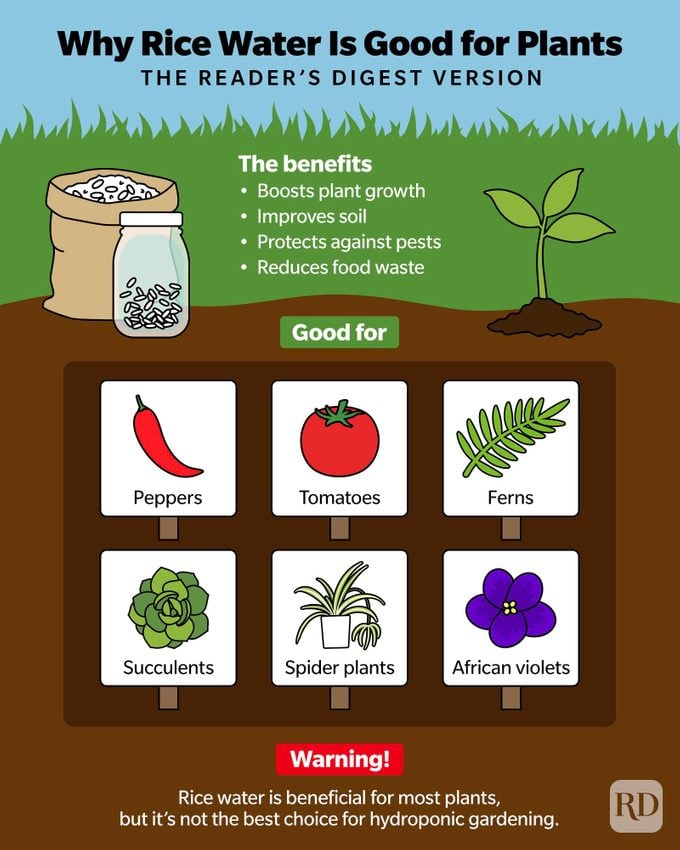
Is rice water good for plants?
Rice is rich in a number of different nutrients, including nitrogen, phosphorous, potassium, magnesium, zinc, iron and sulfur. But when you rinse or boil rice, many of those nutrients wash away in the water. If you repurpose rice water for plants, however, you can redirect all those nutrients to your garden and houseplants, preventing waste from ending up in your trash and compost bin and helping your plants grow better too. But why is rice water good for plants?
Julie Garner, author of Raised Bed Gardening for Beginners, explains that the nutrients in rice water make it a beneficial fertilizer for both indoor and outdoor plants. “It also helps protect your plants from common garden and houseplant pests, [and it] improves soil structure by promoting the growth of beneficial microorganisms,” she says.
And there is science to back this up. One study conducted by the Universitas Terbuka found that a number of different plants, including tomatoes and sweet potatoes, grew taller, produced more leaves and rooted better when dosed with rice water. That’s pretty exciting news, considering rice water is so easy to make and is usually just wasted in most home kitchens!
What is rice water made from?
Every time you rinse or boil rice, you create rice water. Both white and brown rice grains are naturally coated in a fine powder, which is actually starch that rice plants produce during the photosynthesis process. Rinsing or cooking rice releases some of this starch, along with a variety of nutrients, into the water, which you can collect to create a homemade liquid fertilizer.
While rice water can help your garden and houseplants grow better and may even encourage outdoor and indoor flowering plants to produce more blooms, this versatile product isn’t just useful for plants. You can often find rice water in many skin-care products too. That said, as popular as these store-bought rice water products are, they are intended for cosmetic use and often contain other ingredients that won’t benefit your garden. So if you want to use rice water for plants, it’s best to make your own at home.
How often should you water your plants with rice water?
You can include rice water in your regular plant-watering regimen, but like most things, it’s best in moderation. Due to the potential for starch buildup, you’ll want to apply rice water to your plants only once a month.
When you’re not using rice water, stick with your typical tap water or rainwater.
Are there any dangers to using rice water on your plants?
Compared with synthetic fertilizers, rice water is very safe to use on plants, and it won’t cause common issues like leaf burn. But rice water does contain a fair amount of starch, which can build up in your plant pots if you use this DIY fertilizer too often.
Rice water will encourage beneficial bacteria to grow in the soil, which can offer a lot of benefits to plants. But an excess of starch can also promote the growth of harmful bacteria and fungi that can lead to issues like root rot. Additionally, when starch builds up in the soil, it can cause the soil to harden and not drain properly, and it may attract starch-eating insects, such as silverfish.
Which plants like rice water?
Both indoor and outdoor plants can benefit from rice water, and it is even safe to use on edible plants in your fruit and vegetable garden. But while rice water can be applied to pretty much any plant, Garner notes that “it can work particularly well for plants that prefer slightly acidic soil, such as peppers, tomatoes, ferns, various types of succulents, spider plants and African violets.”
If you’re looking for an easy way to enhance your pothos plant care, jade plant care or snake plant care regimen—or if you want to grow even healthier garden plants—rice water can help.
Which plants shouldn’t you try this with?
Although rice water can be beneficial to most plants, it isn’t the best choice for hydroponic gardening. In hydroponics, the starch in rice water can build up and cause an overgrowth of fungi and bacteria. This is less likely to occur in plants grown in a soil-based medium, as soils contain certain microorganisms that process starches more efficiently.
Are some types of rice better for plants than others?
The best type of rice for making rice water is whatever rice you like to cook with! You can use any type of rice to make rice water, including brown, white, jasmine and basmati, so there’s no reason to go out and buy a new type of rice for your plants.
That said, don’t use any rice that has added salt or flavoring, as this may impact the growth of your plants or leave you with dead plants.
How to make rice water for plants
You can make rice water for plants using several different methods, including boiling, soaking and fermentation. “Depending on how you do it, you’ll get different results,” says Deacon. “By soaking rice, you get lactic acid bacteria, yeast, enzymes and starches.” All this will feed your plants and can even prevent plant diseases.
Boiling brings its own benefits and drawbacks. “Boiled rice water may contain more nutrients, but heat can degrade the other good parts,” he says. “Or try fermenting and get the best of both worlds. Variety is the spice of life with plants, [so why not] experiment with each method and see how your plants react?”
Below, you’ll find three simple tutorials that will teach you how to create your own rice water for plants. While each technique offers unique benefits, all these methods will produce nutrient-rich rice water that you can use as a deterrent for pests (the way you’d use neem oil for plants), as a liquid fertilizer or as a nutrient boost for plant watering.
How to boil rice to make rice water
Boiling rice water may release more starches and nutrients into the water, giving you lots of added benefits for your plants. To make boiled rice water, follow the steps below.
Step 1: Make rice
Measure out whatever amount of unsalted rice you’d like to use for a recipe and add it to a cooking pot. Pour in a bit more water than you normally would use to cook rice, stir your rice well and then boil it on medium heat for about 30 to 45 minutes, depending on the type of rice you’re using. Don’t use a rice cooker for this.
Step 2: Strain the rice
When your rice is tender, take it off the stove and allow it to cool slightly. Strain the liquid from the rice grains using a fine mesh sieve. Save the liquid in a jar or bowl and allow it to cool completely.
Step 3: Water your plants
Once your rice water has cooled, it’s ready to use on your plants!
How to soak or wash rice to make rice water
Soaking rice to make rice water is probably the easiest method, and it still produces nutrient-rich rice water. To use this method, all you need to do is follow four easy steps.
Step 1: Add rice to a bowl
Measure out whatever quantity of uncooked rice you’d like to use for a recipe and add it to a small bowl.
Step 2: Pour in water
Cover the rice with warm water.
Step 3: Allow the rice to soak
Stir the rice and water well for about two minutes, and then allow the mixture to soak for 30 to 45 minutes.
Step 4: Strain the rice
After it has soaked, give your rice one more stir and then strain the liquid into a jar or bowl. The resulting liquid is your rice water, and you can use it directly on your plants.
How to make fermented rice water
Fermented rice water takes a bit more time to make, but it will contain higher levels of lactic acid bacteria, which can make your plants more resistant to disease and may even prevent powdery mildew on plants. To make fermented rice water, simply follow the steps below.
Step 1: Add your ingredients
First, make rice water using the soaking method listed above.
Next, pour the rice water into a clean jar, filling the container about three-quarters of the way up. Then add one teaspoon of white sugar and four tablespoons of milk—either cow’s or goat’s milk will work—to the rice water and stir the mixture well.
Step 2: Ferment
After blending the rice water mixture, cover the jar loosely with a lid or a bit of cheesecloth. Allow the mixture to ferment for three to four days at room temperature and out of direct sunlight.
Step 3: Collect the fermented rice water
After the rice water has fermented for a few days, the liquid should be translucent, and it should have a slightly sour smell, somewhat like pickles. Pour this mixture into a watering can and apply it to your plants as needed.
A word of warning: If the finished rice water smells bad after fermenting, toss it out and start over.
How should you feed your plants with rice water?
Regardless of which method you chose for creating rice water, you can use the finished product as a liquid fertilizer or as an add-on to your standard plant-watering practice. Just keep in mind that rice water is not a balanced fertilizer, and it won’t provide all the nutrients your plants need. Still, it will work very well when used in conjunction with other balanced fertilizers or compost.
To water tropical houseplants or outdoor plants with rice water, simply add the rice water to your watering can and use it on your plants once a month. You can pour rice water at the top of the soil line or use it with bottom-watering methods.
As for fermented rice water, you can add it to a plant sprayer and use it as a foliar spray by spritzing it on leaves. There’s no need to dilute the rice water before use; however, if the rice water is very thick, you may need to add a bit of plain water to the mix to prevent it from clogging garden sprayers and misters.
Though you can use rice water on pretty much any plant, the process for cacti and succulent plant care with rice water is a bit different. Since these plants have lower watering needs, you should mist them with rice water only once a month. To do this, add your rice water to a misting bottle and dilute it if needed. Then lightly spray your succulents and cacti with the liquid, applying it to the plants and the top of the soil line.
Like other homemade plant fertilizers, rice water is most effective when used fresh, as it will contain more nutrients and beneficial microbes. But if you make more rice water than you can use right away, you can store the leftovers in the fridge for up to one week. After that, you can pour any extra water on your compost heap as an accelerator, so nothing goes to waste.
Sources:
- Aaron Deacon, founder and owner of Bios Nutrients
- Julie Garner, author of Raised Bed Gardening for Beginners
- Harvard School of Public Health: “Rice”
- Pertanika Journal of Science & Technology: “Wastewater from Washed Rice Water as Plant Nutrient Source: Current Understanding and Knowledge Gaps”
- FST Universitas Terbuka: “The Effect of Watering on Rice Washing Water, MSG Water, and AC (Air Conditioner) Wastewater on Tomato Yields and Yields Components (Lycopersicon esculentum L.) in the Deep Peatland”
- University of Hawaii at Manoa: “Natural Farming: Lactic Acid Bacteria”
- Frontiers in Plant Science: “A Microbial Fermentation Mixture Primes for Resistance Against Powdery Mildew in Wheat”





















